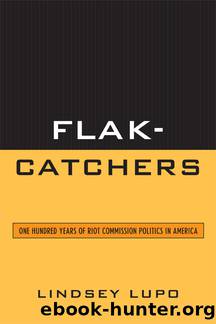Flak-Catchers by Lupo Lindsey;

Author:Lupo, Lindsey; [Lupo]
Language: eng
Format: epub
Publisher: Lexington Books/Fortress Academic
Published: 2010-08-15T00:00:00+00:00
Recommendation
Tone of the Report
Lipsky and Olson refer to the Kerner Commission report as âliberalâ in tone and âhard-hittingâ in nature, but they also contend that it failed to identify specific offenders.71 Kopkind is more critical, referring to the tone as more âliberal rhetoricâ than an actual prescription for policy change.72 Credibility regarding rhetoric was a concern early on for at least one commissioner, Tex Thornton, who in September 1967 declared that the report should have a âstrong flavor in it of some sort of law enforcement, or something that stops the riots,â rather than âjust another commission to come out with a lot of social programs.â73 John Lindsay disagreed, for instance arguing that government-funded youth programs should continue to be funded and should be referenced in the recommendations section.74 This debate over the commissionâs focusâlaw and order versus social welfareâcontinued into the fall of 1967 when a memo was released regarding the commissionâs options for the interim and final reports.75 The commission seemed to be leaning toward an interim report that focused on law and order and a final report that dealt more with underlying social issues. The point was that the interim report would come before the 1968 summer months (riot season) and thus would have to address issues of control, while the final report would come months later when more data was available for them to use as a basis for social recommendations. When the decision was made to release just one report, it didnât address social issues as much as it would have later, when more data would indeed have been available.
The commission was certainly cautious of their tone, credibility, and the public perception of their work. For example, pieces that had been critical of the McCone Commission were circulated for the commissioners to read. In fact, the 1965 Los Angeles riot and the McCone Commission played a large role in the Kerner Commission as commissioners read follow-up reports to the McCone report, spoke with commissioners, including McCone himself, and watched news analyses of Watts in the years following the riot. Fearful of experiencing a similar backlash, the Kerner Commission members wanted to appear decisive and not bogged down by internal conflict. Thus, compromise became the name of the game. Meeting minutes often note that Thornton and Lindsay, the two commissioners at opposite sides of the ideological spectrum, were in agreement. This is not to say that conflict didnât occurâit did. For instance, left-leaning commission members endorsed a policy recommendation for negative income tax while more conservative members felt uneasy making such suggestions.76 The final report compromised on the issue and pointed to another commission set up to study such a tax structure. Such wishy-washiness was exactly what they were trying to avoid but what they ended up doing, despite Palmieriâs urging the writers to âavoid unsupported generalities and loose and discursive writing.â77
Similarly, Ginsburg made the tone of the report one of compromise almost by force as commissioners were made to be incredibly specific in their criticisms.
Download
This site does not store any files on its server. We only index and link to content provided by other sites. Please contact the content providers to delete copyright contents if any and email us, we'll remove relevant links or contents immediately.
The Secret History by Donna Tartt(18083)
The Social Justice Warrior Handbook by Lisa De Pasquale(11941)
Thirteen Reasons Why by Jay Asher(8416)
This Is How You Lose Her by Junot Diaz(6411)
Weapons of Math Destruction by Cathy O'Neil(5800)
Zero to One by Peter Thiel(5461)
Beartown by Fredrik Backman(5304)
The Myth of the Strong Leader by Archie Brown(5217)
The Fire Next Time by James Baldwin(4998)
How Democracies Die by Steven Levitsky & Daniel Ziblatt(4940)
Promise Me, Dad by Joe Biden(4899)
Stone's Rules by Roger Stone(4833)
100 Deadly Skills by Clint Emerson(4661)
Rise and Kill First by Ronen Bergman(4536)
A Higher Loyalty: Truth, Lies, and Leadership by James Comey(4532)
The David Icke Guide to the Global Conspiracy (and how to end it) by David Icke(4359)
Secrecy World by Jake Bernstein(4354)
The Farm by Tom Rob Smith(4305)
The Doomsday Machine by Daniel Ellsberg(4232)
